Nursing Research: Evidence-Based Practice, Ethics, and Diabetes
VerifiedAdded on 2023/04/22
|22
|5943
|227
Homework Assignment
AI Summary
This nursing assignment delves into various aspects of research within the nursing context, covering reasons for undertaking research, credible information sources, and models of evidence-based practice. It discusses evaluating the validity of information, cultural and ethical considerations in research, and processes for analyzing gathered information. The assignment also addresses assessing the strength, relevance, reliability, and currency of information, along with feasibility, benefits, and risks. Furthermore, it explores the impact of beliefs and social support on diabetic patients' self-esteem, client-specific factors, cultural beliefs, and political issues affecting diabetes management. The assignment also touches upon social and economic factors influencing diabetes in Australia, the role of NDSS and Diabetes Australia, and the involvement of general practitioners and endocrinologists in diabetes care. Finally, it includes a case study focusing on factors contributing to high blood glucose levels in a diabetic patient.
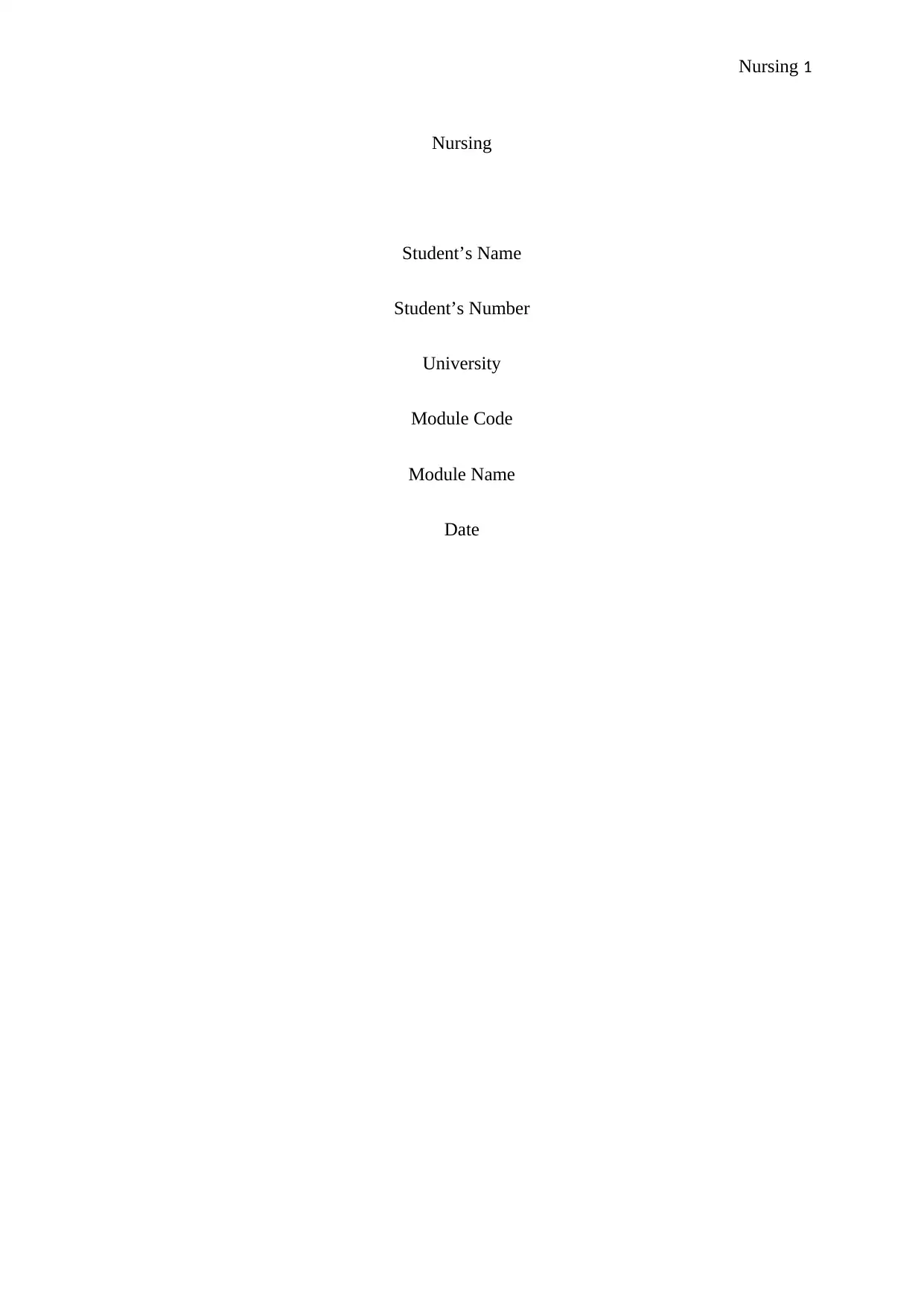
Nursing 1
Nursing
Student’s Name
Student’s Number
University
Module Code
Module Name
Date
Nursing
Student’s Name
Student’s Number
University
Module Code
Module Name
Date
Paraphrase This Document
Need a fresh take? Get an instant paraphrase of this document with our AI Paraphraser
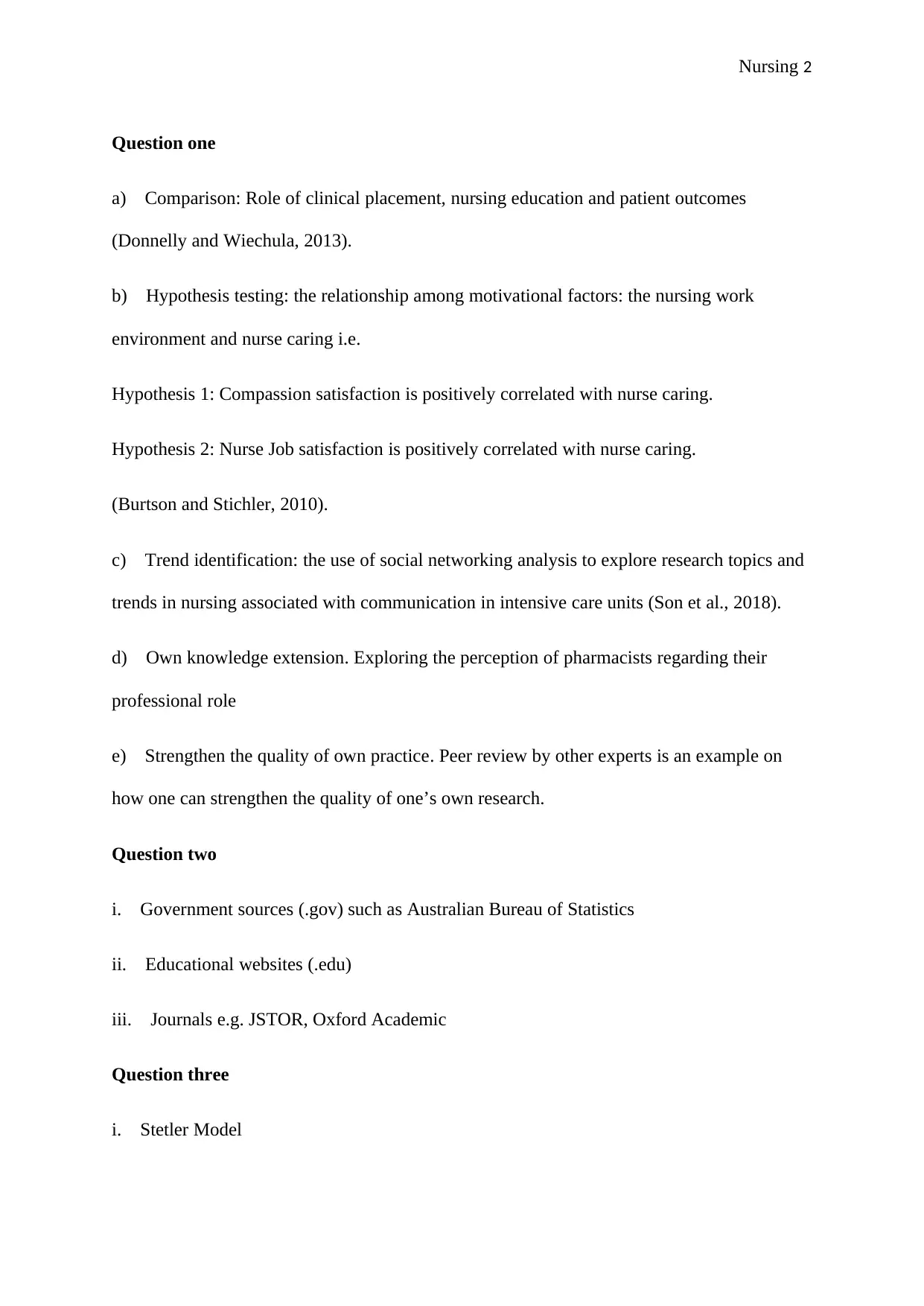
Nursing 2
Question one
a) Comparison: Role of clinical placement, nursing education and patient outcomes
(Donnelly and Wiechula, 2013).
b) Hypothesis testing: the relationship among motivational factors: the nursing work
environment and nurse caring i.e.
Hypothesis 1: Compassion satisfaction is positively correlated with nurse caring.
Hypothesis 2: Nurse Job satisfaction is positively correlated with nurse caring.
(Burtson and Stichler, 2010).
c) Trend identification: the use of social networking analysis to explore research topics and
trends in nursing associated with communication in intensive care units (Son et al., 2018).
d) Own knowledge extension. Exploring the perception of pharmacists regarding their
professional role
e) Strengthen the quality of own practice. Peer review by other experts is an example on
how one can strengthen the quality of one’s own research.
Question two
i. Government sources (.gov) such as Australian Bureau of Statistics
ii. Educational websites (.edu)
iii. Journals e.g. JSTOR, Oxford Academic
Question three
i. Stetler Model
Question one
a) Comparison: Role of clinical placement, nursing education and patient outcomes
(Donnelly and Wiechula, 2013).
b) Hypothesis testing: the relationship among motivational factors: the nursing work
environment and nurse caring i.e.
Hypothesis 1: Compassion satisfaction is positively correlated with nurse caring.
Hypothesis 2: Nurse Job satisfaction is positively correlated with nurse caring.
(Burtson and Stichler, 2010).
c) Trend identification: the use of social networking analysis to explore research topics and
trends in nursing associated with communication in intensive care units (Son et al., 2018).
d) Own knowledge extension. Exploring the perception of pharmacists regarding their
professional role
e) Strengthen the quality of own practice. Peer review by other experts is an example on
how one can strengthen the quality of one’s own research.
Question two
i. Government sources (.gov) such as Australian Bureau of Statistics
ii. Educational websites (.edu)
iii. Journals e.g. JSTOR, Oxford Academic
Question three
i. Stetler Model
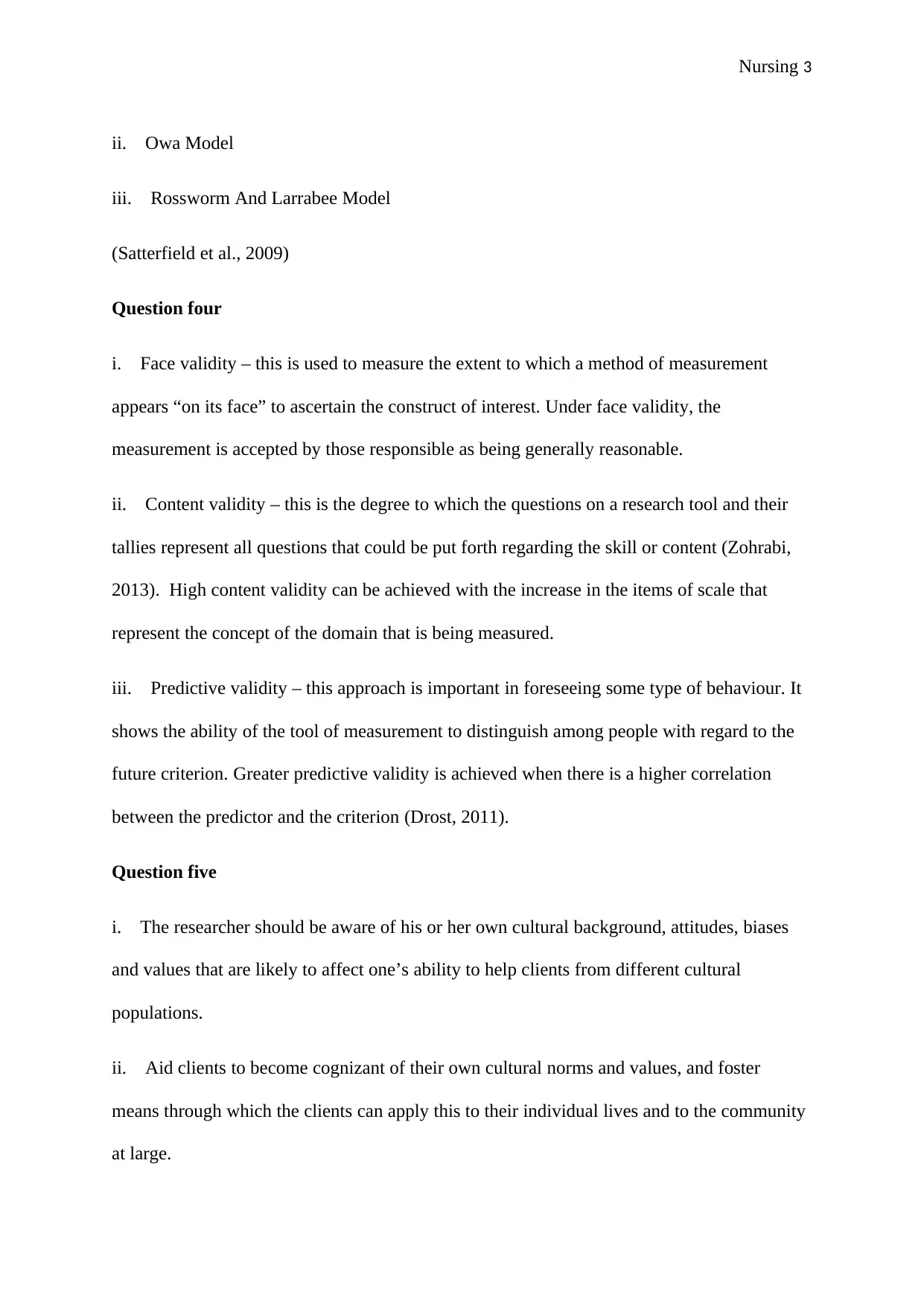
Nursing 3
ii. Owa Model
iii. Rossworm And Larrabee Model
(Satterfield et al., 2009)
Question four
i. Face validity – this is used to measure the extent to which a method of measurement
appears “on its face” to ascertain the construct of interest. Under face validity, the
measurement is accepted by those responsible as being generally reasonable.
ii. Content validity – this is the degree to which the questions on a research tool and their
tallies represent all questions that could be put forth regarding the skill or content (Zohrabi,
2013). High content validity can be achieved with the increase in the items of scale that
represent the concept of the domain that is being measured.
iii. Predictive validity – this approach is important in foreseeing some type of behaviour. It
shows the ability of the tool of measurement to distinguish among people with regard to the
future criterion. Greater predictive validity is achieved when there is a higher correlation
between the predictor and the criterion (Drost, 2011).
Question five
i. The researcher should be aware of his or her own cultural background, attitudes, biases
and values that are likely to affect one’s ability to help clients from different cultural
populations.
ii. Aid clients to become cognizant of their own cultural norms and values, and foster
means through which the clients can apply this to their individual lives and to the community
at large.
ii. Owa Model
iii. Rossworm And Larrabee Model
(Satterfield et al., 2009)
Question four
i. Face validity – this is used to measure the extent to which a method of measurement
appears “on its face” to ascertain the construct of interest. Under face validity, the
measurement is accepted by those responsible as being generally reasonable.
ii. Content validity – this is the degree to which the questions on a research tool and their
tallies represent all questions that could be put forth regarding the skill or content (Zohrabi,
2013). High content validity can be achieved with the increase in the items of scale that
represent the concept of the domain that is being measured.
iii. Predictive validity – this approach is important in foreseeing some type of behaviour. It
shows the ability of the tool of measurement to distinguish among people with regard to the
future criterion. Greater predictive validity is achieved when there is a higher correlation
between the predictor and the criterion (Drost, 2011).
Question five
i. The researcher should be aware of his or her own cultural background, attitudes, biases
and values that are likely to affect one’s ability to help clients from different cultural
populations.
ii. Aid clients to become cognizant of their own cultural norms and values, and foster
means through which the clients can apply this to their individual lives and to the community
at large.
⊘ This is a preview!⊘
Do you want full access?
Subscribe today to unlock all pages.

Trusted by 1+ million students worldwide
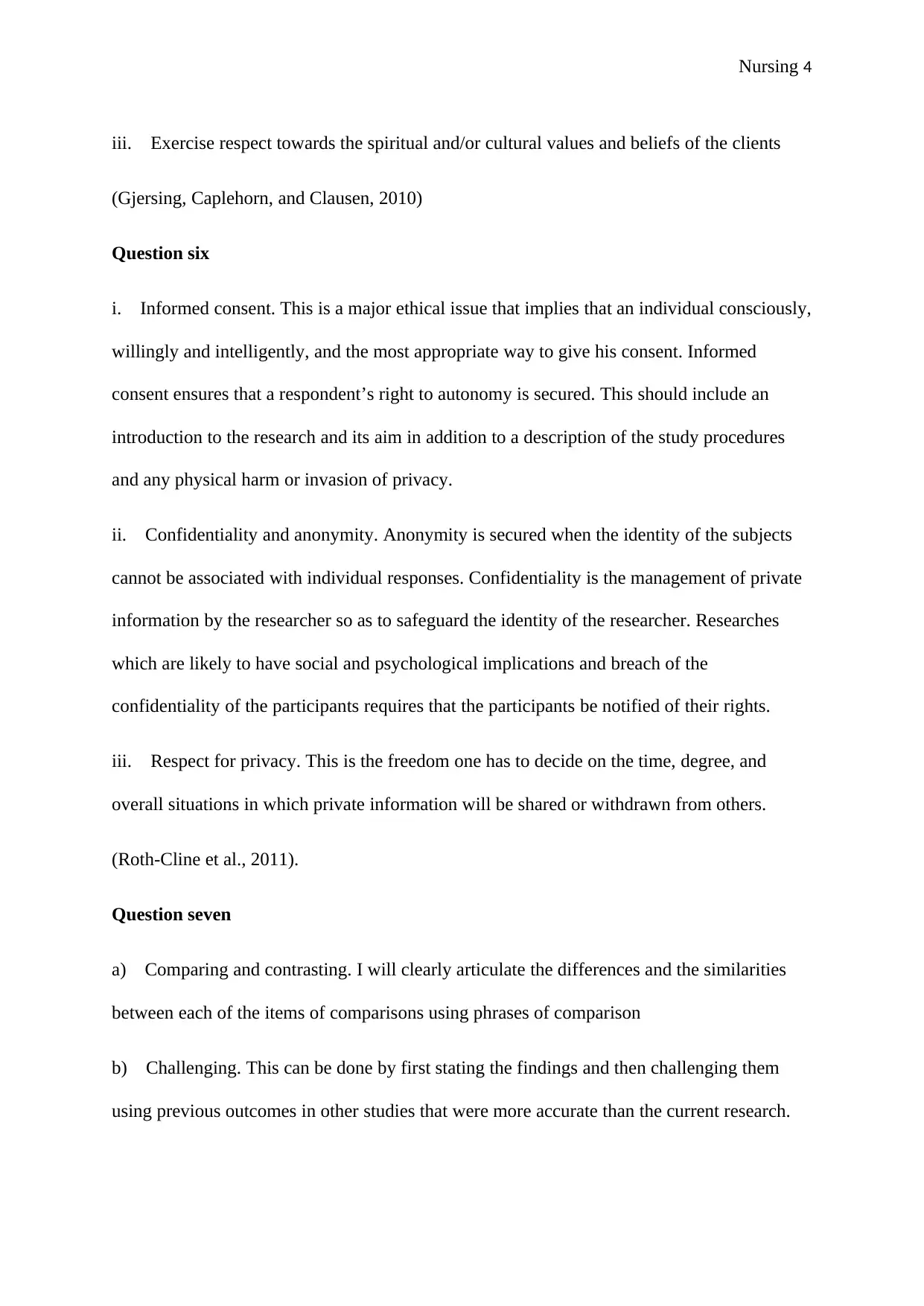
Nursing 4
iii. Exercise respect towards the spiritual and/or cultural values and beliefs of the clients
(Gjersing, Caplehorn, and Clausen, 2010)
Question six
i. Informed consent. This is a major ethical issue that implies that an individual consciously,
willingly and intelligently, and the most appropriate way to give his consent. Informed
consent ensures that a respondent’s right to autonomy is secured. This should include an
introduction to the research and its aim in addition to a description of the study procedures
and any physical harm or invasion of privacy.
ii. Confidentiality and anonymity. Anonymity is secured when the identity of the subjects
cannot be associated with individual responses. Confidentiality is the management of private
information by the researcher so as to safeguard the identity of the researcher. Researches
which are likely to have social and psychological implications and breach of the
confidentiality of the participants requires that the participants be notified of their rights.
iii. Respect for privacy. This is the freedom one has to decide on the time, degree, and
overall situations in which private information will be shared or withdrawn from others.
(Roth-Cline et al., 2011).
Question seven
a) Comparing and contrasting. I will clearly articulate the differences and the similarities
between each of the items of comparisons using phrases of comparison
b) Challenging. This can be done by first stating the findings and then challenging them
using previous outcomes in other studies that were more accurate than the current research.
iii. Exercise respect towards the spiritual and/or cultural values and beliefs of the clients
(Gjersing, Caplehorn, and Clausen, 2010)
Question six
i. Informed consent. This is a major ethical issue that implies that an individual consciously,
willingly and intelligently, and the most appropriate way to give his consent. Informed
consent ensures that a respondent’s right to autonomy is secured. This should include an
introduction to the research and its aim in addition to a description of the study procedures
and any physical harm or invasion of privacy.
ii. Confidentiality and anonymity. Anonymity is secured when the identity of the subjects
cannot be associated with individual responses. Confidentiality is the management of private
information by the researcher so as to safeguard the identity of the researcher. Researches
which are likely to have social and psychological implications and breach of the
confidentiality of the participants requires that the participants be notified of their rights.
iii. Respect for privacy. This is the freedom one has to decide on the time, degree, and
overall situations in which private information will be shared or withdrawn from others.
(Roth-Cline et al., 2011).
Question seven
a) Comparing and contrasting. I will clearly articulate the differences and the similarities
between each of the items of comparisons using phrases of comparison
b) Challenging. This can be done by first stating the findings and then challenging them
using previous outcomes in other studies that were more accurate than the current research.
Paraphrase This Document
Need a fresh take? Get an instant paraphrase of this document with our AI Paraphraser
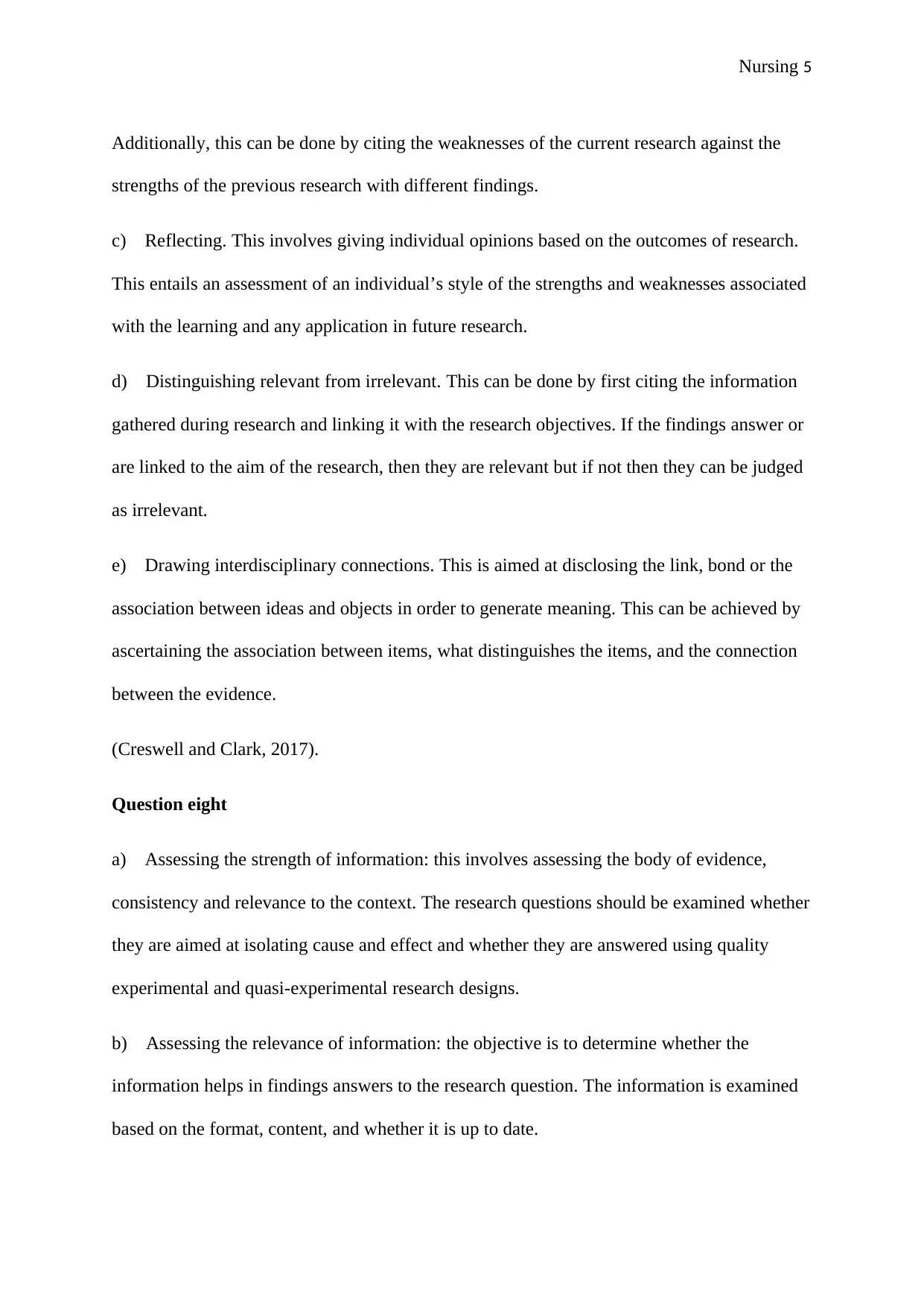
Nursing 5
Additionally, this can be done by citing the weaknesses of the current research against the
strengths of the previous research with different findings.
c) Reflecting. This involves giving individual opinions based on the outcomes of research.
This entails an assessment of an individual’s style of the strengths and weaknesses associated
with the learning and any application in future research.
d) Distinguishing relevant from irrelevant. This can be done by first citing the information
gathered during research and linking it with the research objectives. If the findings answer or
are linked to the aim of the research, then they are relevant but if not then they can be judged
as irrelevant.
e) Drawing interdisciplinary connections. This is aimed at disclosing the link, bond or the
association between ideas and objects in order to generate meaning. This can be achieved by
ascertaining the association between items, what distinguishes the items, and the connection
between the evidence.
(Creswell and Clark, 2017).
Question eight
a) Assessing the strength of information: this involves assessing the body of evidence,
consistency and relevance to the context. The research questions should be examined whether
they are aimed at isolating cause and effect and whether they are answered using quality
experimental and quasi-experimental research designs.
b) Assessing the relevance of information: the objective is to determine whether the
information helps in findings answers to the research question. The information is examined
based on the format, content, and whether it is up to date.
Additionally, this can be done by citing the weaknesses of the current research against the
strengths of the previous research with different findings.
c) Reflecting. This involves giving individual opinions based on the outcomes of research.
This entails an assessment of an individual’s style of the strengths and weaknesses associated
with the learning and any application in future research.
d) Distinguishing relevant from irrelevant. This can be done by first citing the information
gathered during research and linking it with the research objectives. If the findings answer or
are linked to the aim of the research, then they are relevant but if not then they can be judged
as irrelevant.
e) Drawing interdisciplinary connections. This is aimed at disclosing the link, bond or the
association between ideas and objects in order to generate meaning. This can be achieved by
ascertaining the association between items, what distinguishes the items, and the connection
between the evidence.
(Creswell and Clark, 2017).
Question eight
a) Assessing the strength of information: this involves assessing the body of evidence,
consistency and relevance to the context. The research questions should be examined whether
they are aimed at isolating cause and effect and whether they are answered using quality
experimental and quasi-experimental research designs.
b) Assessing the relevance of information: the objective is to determine whether the
information helps in findings answers to the research question. The information is examined
based on the format, content, and whether it is up to date.
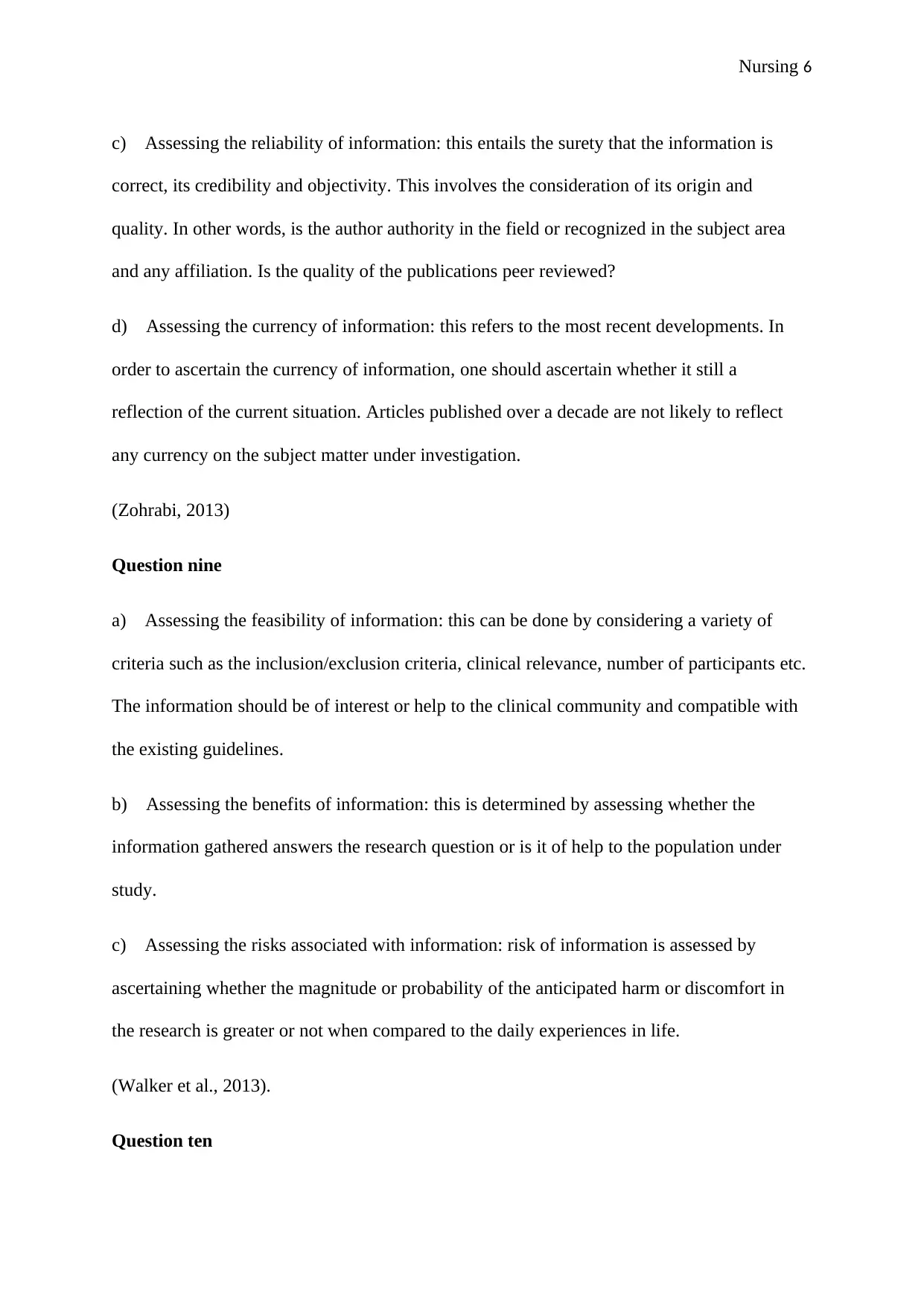
Nursing 6
c) Assessing the reliability of information: this entails the surety that the information is
correct, its credibility and objectivity. This involves the consideration of its origin and
quality. In other words, is the author authority in the field or recognized in the subject area
and any affiliation. Is the quality of the publications peer reviewed?
d) Assessing the currency of information: this refers to the most recent developments. In
order to ascertain the currency of information, one should ascertain whether it still a
reflection of the current situation. Articles published over a decade are not likely to reflect
any currency on the subject matter under investigation.
(Zohrabi, 2013)
Question nine
a) Assessing the feasibility of information: this can be done by considering a variety of
criteria such as the inclusion/exclusion criteria, clinical relevance, number of participants etc.
The information should be of interest or help to the clinical community and compatible with
the existing guidelines.
b) Assessing the benefits of information: this is determined by assessing whether the
information gathered answers the research question or is it of help to the population under
study.
c) Assessing the risks associated with information: risk of information is assessed by
ascertaining whether the magnitude or probability of the anticipated harm or discomfort in
the research is greater or not when compared to the daily experiences in life.
(Walker et al., 2013).
Question ten
c) Assessing the reliability of information: this entails the surety that the information is
correct, its credibility and objectivity. This involves the consideration of its origin and
quality. In other words, is the author authority in the field or recognized in the subject area
and any affiliation. Is the quality of the publications peer reviewed?
d) Assessing the currency of information: this refers to the most recent developments. In
order to ascertain the currency of information, one should ascertain whether it still a
reflection of the current situation. Articles published over a decade are not likely to reflect
any currency on the subject matter under investigation.
(Zohrabi, 2013)
Question nine
a) Assessing the feasibility of information: this can be done by considering a variety of
criteria such as the inclusion/exclusion criteria, clinical relevance, number of participants etc.
The information should be of interest or help to the clinical community and compatible with
the existing guidelines.
b) Assessing the benefits of information: this is determined by assessing whether the
information gathered answers the research question or is it of help to the population under
study.
c) Assessing the risks associated with information: risk of information is assessed by
ascertaining whether the magnitude or probability of the anticipated harm or discomfort in
the research is greater or not when compared to the daily experiences in life.
(Walker et al., 2013).
Question ten
⊘ This is a preview!⊘
Do you want full access?
Subscribe today to unlock all pages.

Trusted by 1+ million students worldwide
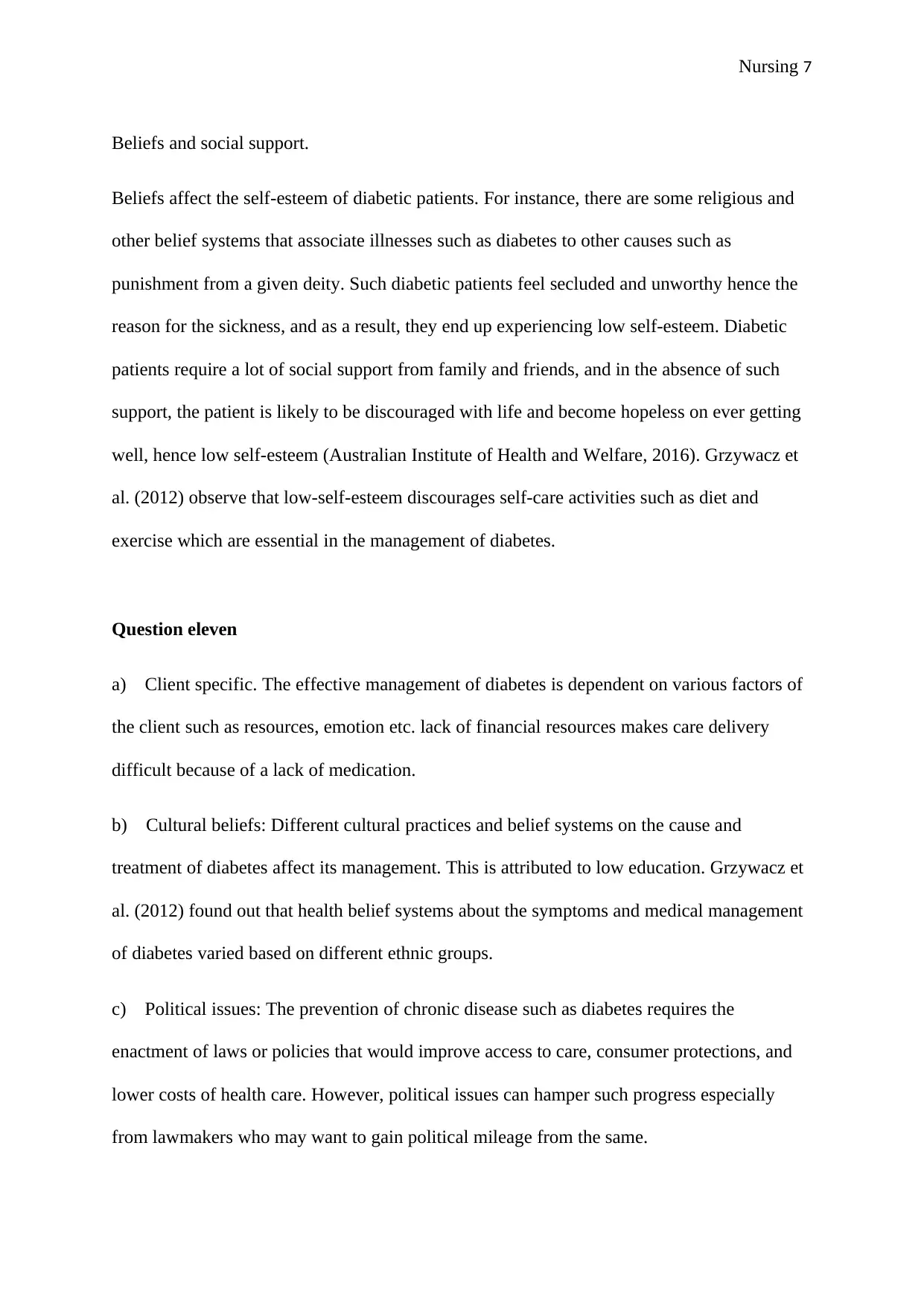
Nursing 7
Beliefs and social support.
Beliefs affect the self-esteem of diabetic patients. For instance, there are some religious and
other belief systems that associate illnesses such as diabetes to other causes such as
punishment from a given deity. Such diabetic patients feel secluded and unworthy hence the
reason for the sickness, and as a result, they end up experiencing low self-esteem. Diabetic
patients require a lot of social support from family and friends, and in the absence of such
support, the patient is likely to be discouraged with life and become hopeless on ever getting
well, hence low self-esteem (Australian Institute of Health and Welfare, 2016). Grzywacz et
al. (2012) observe that low-self-esteem discourages self-care activities such as diet and
exercise which are essential in the management of diabetes.
Question eleven
a) Client specific. The effective management of diabetes is dependent on various factors of
the client such as resources, emotion etc. lack of financial resources makes care delivery
difficult because of a lack of medication.
b) Cultural beliefs: Different cultural practices and belief systems on the cause and
treatment of diabetes affect its management. This is attributed to low education. Grzywacz et
al. (2012) found out that health belief systems about the symptoms and medical management
of diabetes varied based on different ethnic groups.
c) Political issues: The prevention of chronic disease such as diabetes requires the
enactment of laws or policies that would improve access to care, consumer protections, and
lower costs of health care. However, political issues can hamper such progress especially
from lawmakers who may want to gain political mileage from the same.
Beliefs and social support.
Beliefs affect the self-esteem of diabetic patients. For instance, there are some religious and
other belief systems that associate illnesses such as diabetes to other causes such as
punishment from a given deity. Such diabetic patients feel secluded and unworthy hence the
reason for the sickness, and as a result, they end up experiencing low self-esteem. Diabetic
patients require a lot of social support from family and friends, and in the absence of such
support, the patient is likely to be discouraged with life and become hopeless on ever getting
well, hence low self-esteem (Australian Institute of Health and Welfare, 2016). Grzywacz et
al. (2012) observe that low-self-esteem discourages self-care activities such as diet and
exercise which are essential in the management of diabetes.
Question eleven
a) Client specific. The effective management of diabetes is dependent on various factors of
the client such as resources, emotion etc. lack of financial resources makes care delivery
difficult because of a lack of medication.
b) Cultural beliefs: Different cultural practices and belief systems on the cause and
treatment of diabetes affect its management. This is attributed to low education. Grzywacz et
al. (2012) found out that health belief systems about the symptoms and medical management
of diabetes varied based on different ethnic groups.
c) Political issues: The prevention of chronic disease such as diabetes requires the
enactment of laws or policies that would improve access to care, consumer protections, and
lower costs of health care. However, political issues can hamper such progress especially
from lawmakers who may want to gain political mileage from the same.
Paraphrase This Document
Need a fresh take? Get an instant paraphrase of this document with our AI Paraphraser
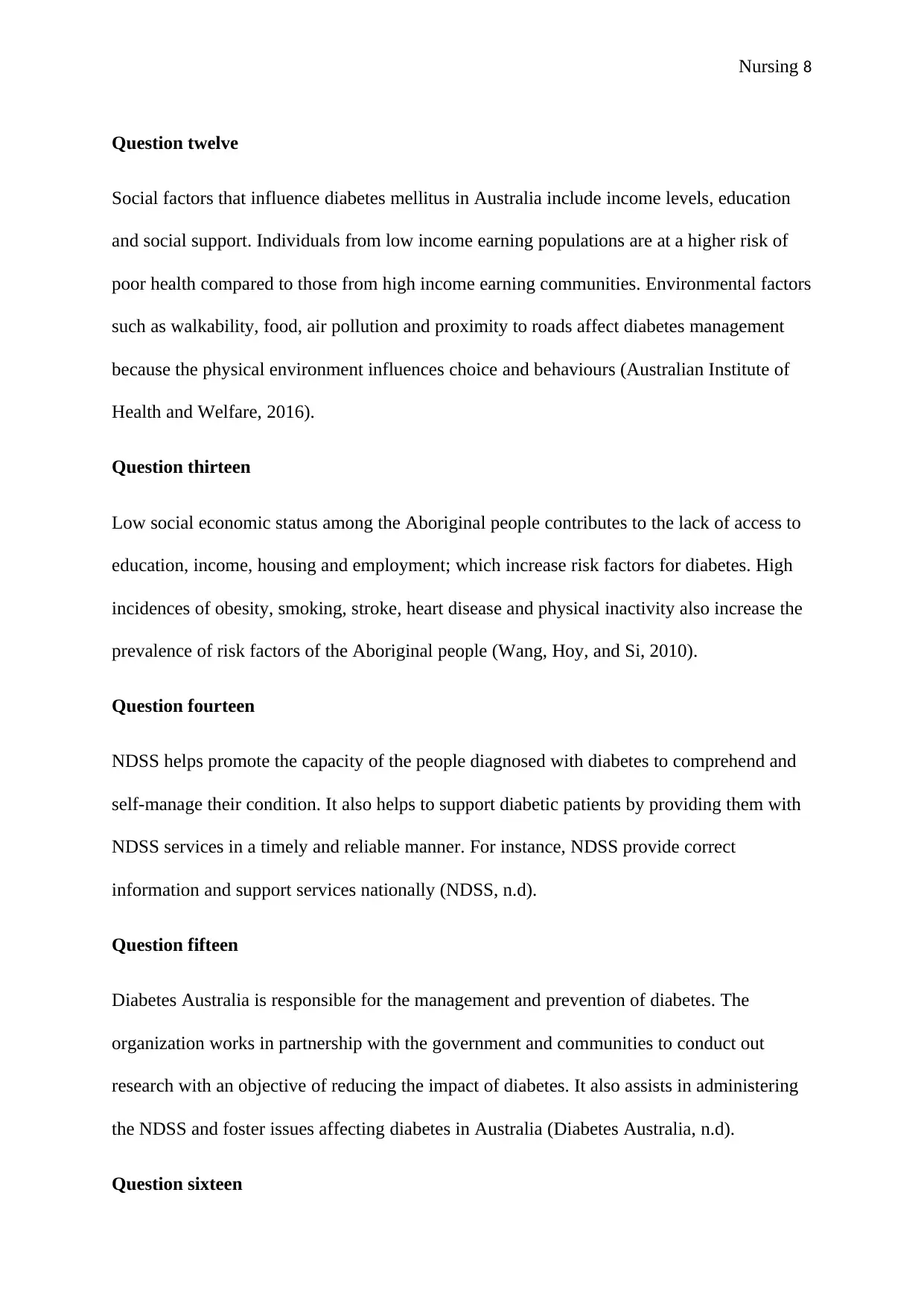
Nursing 8
Question twelve
Social factors that influence diabetes mellitus in Australia include income levels, education
and social support. Individuals from low income earning populations are at a higher risk of
poor health compared to those from high income earning communities. Environmental factors
such as walkability, food, air pollution and proximity to roads affect diabetes management
because the physical environment influences choice and behaviours (Australian Institute of
Health and Welfare, 2016).
Question thirteen
Low social economic status among the Aboriginal people contributes to the lack of access to
education, income, housing and employment; which increase risk factors for diabetes. High
incidences of obesity, smoking, stroke, heart disease and physical inactivity also increase the
prevalence of risk factors of the Aboriginal people (Wang, Hoy, and Si, 2010).
Question fourteen
NDSS helps promote the capacity of the people diagnosed with diabetes to comprehend and
self-manage their condition. It also helps to support diabetic patients by providing them with
NDSS services in a timely and reliable manner. For instance, NDSS provide correct
information and support services nationally (NDSS, n.d).
Question fifteen
Diabetes Australia is responsible for the management and prevention of diabetes. The
organization works in partnership with the government and communities to conduct out
research with an objective of reducing the impact of diabetes. It also assists in administering
the NDSS and foster issues affecting diabetes in Australia (Diabetes Australia, n.d).
Question sixteen
Question twelve
Social factors that influence diabetes mellitus in Australia include income levels, education
and social support. Individuals from low income earning populations are at a higher risk of
poor health compared to those from high income earning communities. Environmental factors
such as walkability, food, air pollution and proximity to roads affect diabetes management
because the physical environment influences choice and behaviours (Australian Institute of
Health and Welfare, 2016).
Question thirteen
Low social economic status among the Aboriginal people contributes to the lack of access to
education, income, housing and employment; which increase risk factors for diabetes. High
incidences of obesity, smoking, stroke, heart disease and physical inactivity also increase the
prevalence of risk factors of the Aboriginal people (Wang, Hoy, and Si, 2010).
Question fourteen
NDSS helps promote the capacity of the people diagnosed with diabetes to comprehend and
self-manage their condition. It also helps to support diabetic patients by providing them with
NDSS services in a timely and reliable manner. For instance, NDSS provide correct
information and support services nationally (NDSS, n.d).
Question fifteen
Diabetes Australia is responsible for the management and prevention of diabetes. The
organization works in partnership with the government and communities to conduct out
research with an objective of reducing the impact of diabetes. It also assists in administering
the NDSS and foster issues affecting diabetes in Australia (Diabetes Australia, n.d).
Question sixteen
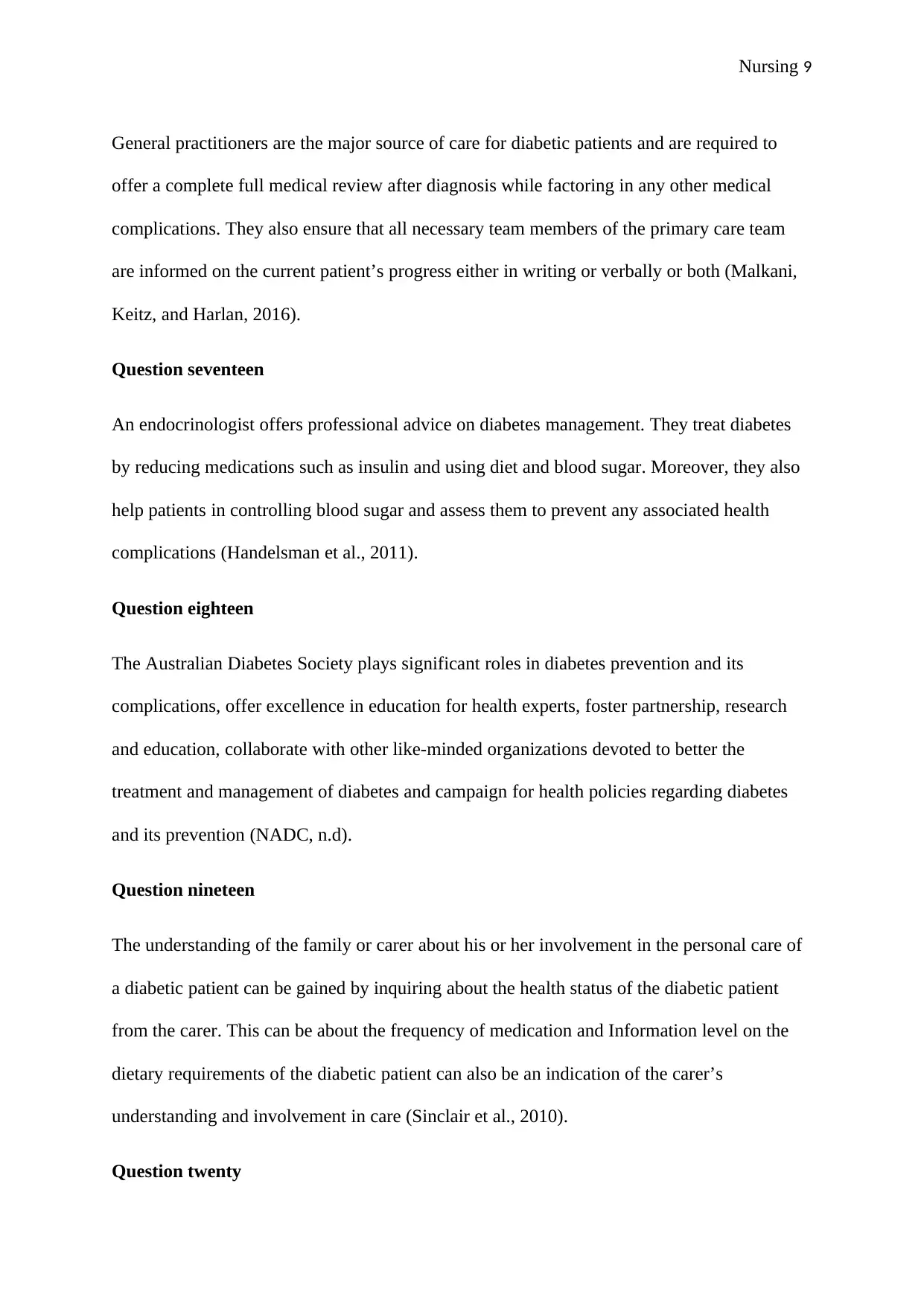
Nursing 9
General practitioners are the major source of care for diabetic patients and are required to
offer a complete full medical review after diagnosis while factoring in any other medical
complications. They also ensure that all necessary team members of the primary care team
are informed on the current patient’s progress either in writing or verbally or both (Malkani,
Keitz, and Harlan, 2016).
Question seventeen
An endocrinologist offers professional advice on diabetes management. They treat diabetes
by reducing medications such as insulin and using diet and blood sugar. Moreover, they also
help patients in controlling blood sugar and assess them to prevent any associated health
complications (Handelsman et al., 2011).
Question eighteen
The Australian Diabetes Society plays significant roles in diabetes prevention and its
complications, offer excellence in education for health experts, foster partnership, research
and education, collaborate with other like-minded organizations devoted to better the
treatment and management of diabetes and campaign for health policies regarding diabetes
and its prevention (NADC, n.d).
Question nineteen
The understanding of the family or carer about his or her involvement in the personal care of
a diabetic patient can be gained by inquiring about the health status of the diabetic patient
from the carer. This can be about the frequency of medication and Information level on the
dietary requirements of the diabetic patient can also be an indication of the carer’s
understanding and involvement in care (Sinclair et al., 2010).
Question twenty
General practitioners are the major source of care for diabetic patients and are required to
offer a complete full medical review after diagnosis while factoring in any other medical
complications. They also ensure that all necessary team members of the primary care team
are informed on the current patient’s progress either in writing or verbally or both (Malkani,
Keitz, and Harlan, 2016).
Question seventeen
An endocrinologist offers professional advice on diabetes management. They treat diabetes
by reducing medications such as insulin and using diet and blood sugar. Moreover, they also
help patients in controlling blood sugar and assess them to prevent any associated health
complications (Handelsman et al., 2011).
Question eighteen
The Australian Diabetes Society plays significant roles in diabetes prevention and its
complications, offer excellence in education for health experts, foster partnership, research
and education, collaborate with other like-minded organizations devoted to better the
treatment and management of diabetes and campaign for health policies regarding diabetes
and its prevention (NADC, n.d).
Question nineteen
The understanding of the family or carer about his or her involvement in the personal care of
a diabetic patient can be gained by inquiring about the health status of the diabetic patient
from the carer. This can be about the frequency of medication and Information level on the
dietary requirements of the diabetic patient can also be an indication of the carer’s
understanding and involvement in care (Sinclair et al., 2010).
Question twenty
⊘ This is a preview!⊘
Do you want full access?
Subscribe today to unlock all pages.

Trusted by 1+ million students worldwide
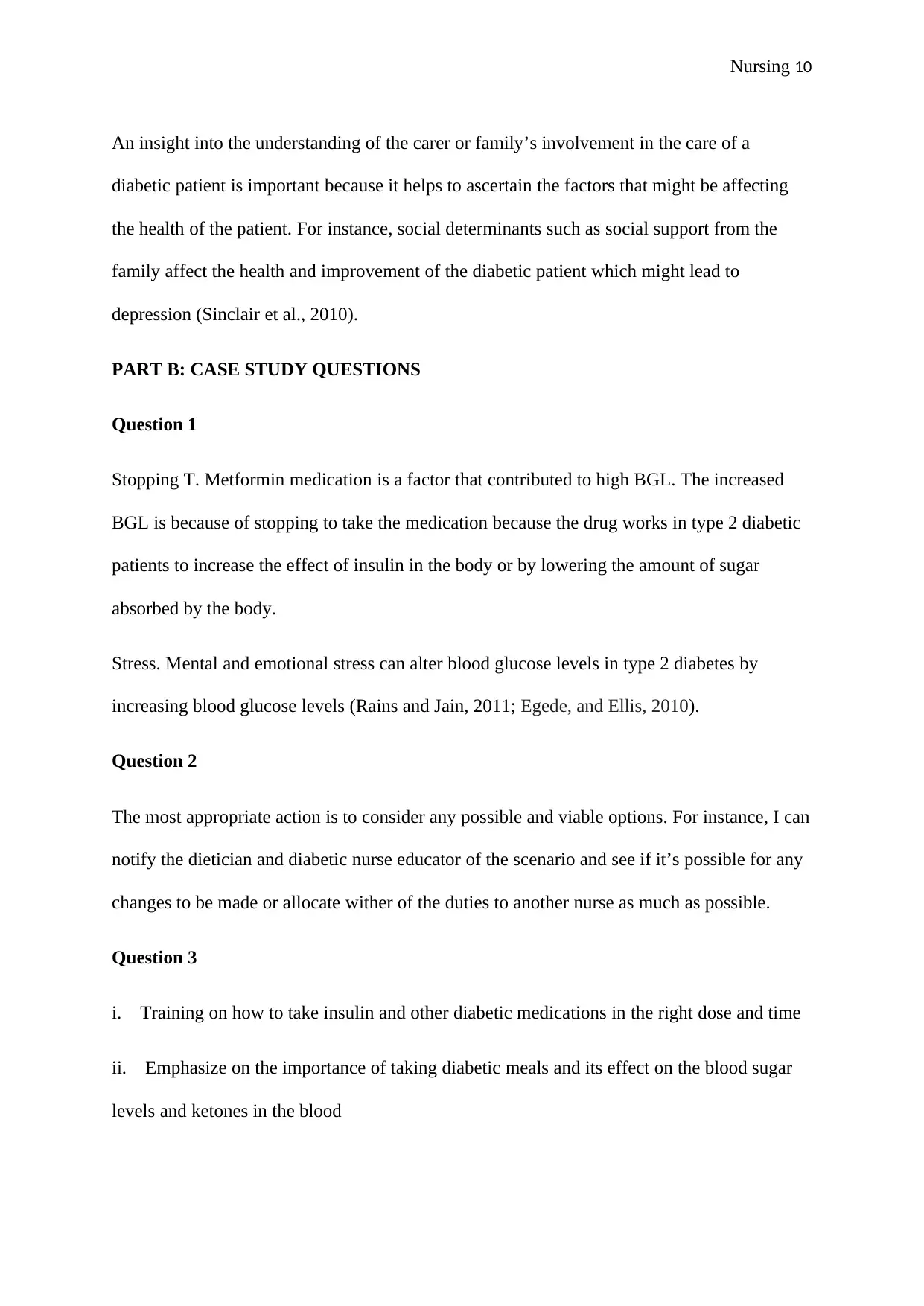
Nursing 10
An insight into the understanding of the carer or family’s involvement in the care of a
diabetic patient is important because it helps to ascertain the factors that might be affecting
the health of the patient. For instance, social determinants such as social support from the
family affect the health and improvement of the diabetic patient which might lead to
depression (Sinclair et al., 2010).
PART B: CASE STUDY QUESTIONS
Question 1
Stopping T. Metformin medication is a factor that contributed to high BGL. The increased
BGL is because of stopping to take the medication because the drug works in type 2 diabetic
patients to increase the effect of insulin in the body or by lowering the amount of sugar
absorbed by the body.
Stress. Mental and emotional stress can alter blood glucose levels in type 2 diabetes by
increasing blood glucose levels (Rains and Jain, 2011; Egede, and Ellis, 2010).
Question 2
The most appropriate action is to consider any possible and viable options. For instance, I can
notify the dietician and diabetic nurse educator of the scenario and see if it’s possible for any
changes to be made or allocate wither of the duties to another nurse as much as possible.
Question 3
i. Training on how to take insulin and other diabetic medications in the right dose and time
ii. Emphasize on the importance of taking diabetic meals and its effect on the blood sugar
levels and ketones in the blood
An insight into the understanding of the carer or family’s involvement in the care of a
diabetic patient is important because it helps to ascertain the factors that might be affecting
the health of the patient. For instance, social determinants such as social support from the
family affect the health and improvement of the diabetic patient which might lead to
depression (Sinclair et al., 2010).
PART B: CASE STUDY QUESTIONS
Question 1
Stopping T. Metformin medication is a factor that contributed to high BGL. The increased
BGL is because of stopping to take the medication because the drug works in type 2 diabetic
patients to increase the effect of insulin in the body or by lowering the amount of sugar
absorbed by the body.
Stress. Mental and emotional stress can alter blood glucose levels in type 2 diabetes by
increasing blood glucose levels (Rains and Jain, 2011; Egede, and Ellis, 2010).
Question 2
The most appropriate action is to consider any possible and viable options. For instance, I can
notify the dietician and diabetic nurse educator of the scenario and see if it’s possible for any
changes to be made or allocate wither of the duties to another nurse as much as possible.
Question 3
i. Training on how to take insulin and other diabetic medications in the right dose and time
ii. Emphasize on the importance of taking diabetic meals and its effect on the blood sugar
levels and ketones in the blood
Paraphrase This Document
Need a fresh take? Get an instant paraphrase of this document with our AI Paraphraser
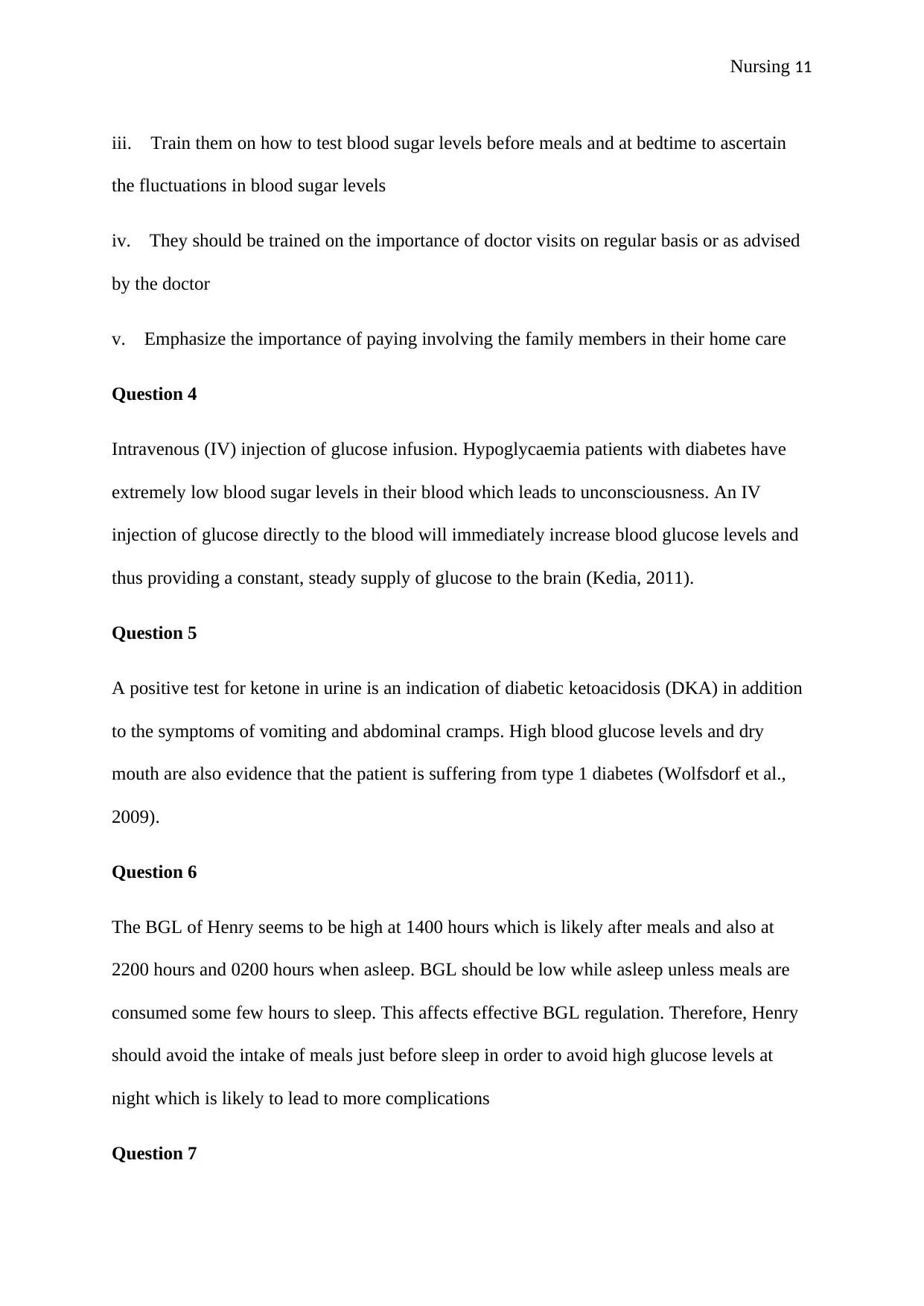
Nursing 11
iii. Train them on how to test blood sugar levels before meals and at bedtime to ascertain
the fluctuations in blood sugar levels
iv. They should be trained on the importance of doctor visits on regular basis or as advised
by the doctor
v. Emphasize the importance of paying involving the family members in their home care
Question 4
Intravenous (IV) injection of glucose infusion. Hypoglycaemia patients with diabetes have
extremely low blood sugar levels in their blood which leads to unconsciousness. An IV
injection of glucose directly to the blood will immediately increase blood glucose levels and
thus providing a constant, steady supply of glucose to the brain (Kedia, 2011).
Question 5
A positive test for ketone in urine is an indication of diabetic ketoacidosis (DKA) in addition
to the symptoms of vomiting and abdominal cramps. High blood glucose levels and dry
mouth are also evidence that the patient is suffering from type 1 diabetes (Wolfsdorf et al.,
2009).
Question 6
The BGL of Henry seems to be high at 1400 hours which is likely after meals and also at
2200 hours and 0200 hours when asleep. BGL should be low while asleep unless meals are
consumed some few hours to sleep. This affects effective BGL regulation. Therefore, Henry
should avoid the intake of meals just before sleep in order to avoid high glucose levels at
night which is likely to lead to more complications
Question 7
iii. Train them on how to test blood sugar levels before meals and at bedtime to ascertain
the fluctuations in blood sugar levels
iv. They should be trained on the importance of doctor visits on regular basis or as advised
by the doctor
v. Emphasize the importance of paying involving the family members in their home care
Question 4
Intravenous (IV) injection of glucose infusion. Hypoglycaemia patients with diabetes have
extremely low blood sugar levels in their blood which leads to unconsciousness. An IV
injection of glucose directly to the blood will immediately increase blood glucose levels and
thus providing a constant, steady supply of glucose to the brain (Kedia, 2011).
Question 5
A positive test for ketone in urine is an indication of diabetic ketoacidosis (DKA) in addition
to the symptoms of vomiting and abdominal cramps. High blood glucose levels and dry
mouth are also evidence that the patient is suffering from type 1 diabetes (Wolfsdorf et al.,
2009).
Question 6
The BGL of Henry seems to be high at 1400 hours which is likely after meals and also at
2200 hours and 0200 hours when asleep. BGL should be low while asleep unless meals are
consumed some few hours to sleep. This affects effective BGL regulation. Therefore, Henry
should avoid the intake of meals just before sleep in order to avoid high glucose levels at
night which is likely to lead to more complications
Question 7
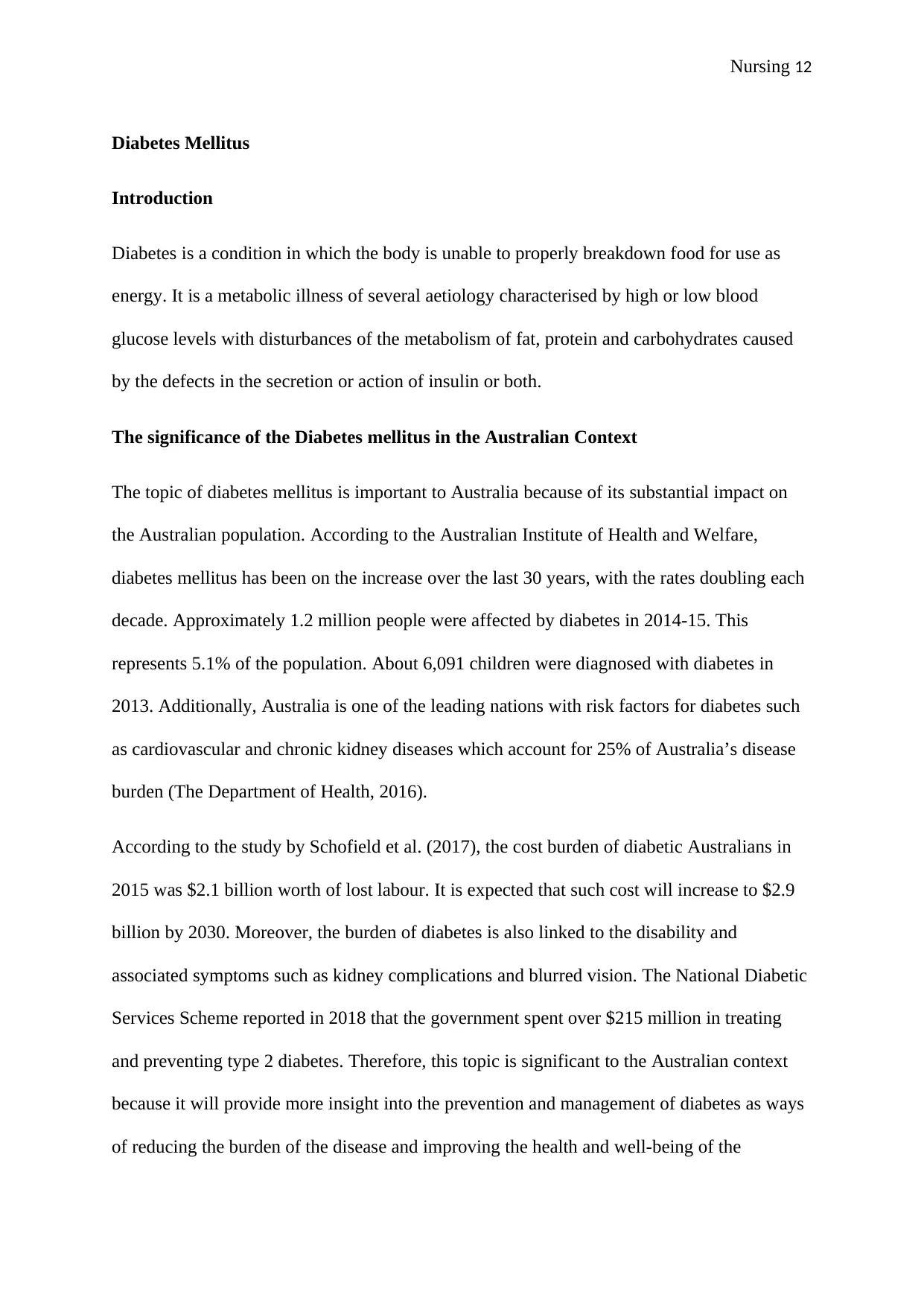
Nursing 12
Diabetes Mellitus
Introduction
Diabetes is a condition in which the body is unable to properly breakdown food for use as
energy. It is a metabolic illness of several aetiology characterised by high or low blood
glucose levels with disturbances of the metabolism of fat, protein and carbohydrates caused
by the defects in the secretion or action of insulin or both.
The significance of the Diabetes mellitus in the Australian Context
The topic of diabetes mellitus is important to Australia because of its substantial impact on
the Australian population. According to the Australian Institute of Health and Welfare,
diabetes mellitus has been on the increase over the last 30 years, with the rates doubling each
decade. Approximately 1.2 million people were affected by diabetes in 2014-15. This
represents 5.1% of the population. About 6,091 children were diagnosed with diabetes in
2013. Additionally, Australia is one of the leading nations with risk factors for diabetes such
as cardiovascular and chronic kidney diseases which account for 25% of Australia’s disease
burden (The Department of Health, 2016).
According to the study by Schofield et al. (2017), the cost burden of diabetic Australians in
2015 was $2.1 billion worth of lost labour. It is expected that such cost will increase to $2.9
billion by 2030. Moreover, the burden of diabetes is also linked to the disability and
associated symptoms such as kidney complications and blurred vision. The National Diabetic
Services Scheme reported in 2018 that the government spent over $215 million in treating
and preventing type 2 diabetes. Therefore, this topic is significant to the Australian context
because it will provide more insight into the prevention and management of diabetes as ways
of reducing the burden of the disease and improving the health and well-being of the
Diabetes Mellitus
Introduction
Diabetes is a condition in which the body is unable to properly breakdown food for use as
energy. It is a metabolic illness of several aetiology characterised by high or low blood
glucose levels with disturbances of the metabolism of fat, protein and carbohydrates caused
by the defects in the secretion or action of insulin or both.
The significance of the Diabetes mellitus in the Australian Context
The topic of diabetes mellitus is important to Australia because of its substantial impact on
the Australian population. According to the Australian Institute of Health and Welfare,
diabetes mellitus has been on the increase over the last 30 years, with the rates doubling each
decade. Approximately 1.2 million people were affected by diabetes in 2014-15. This
represents 5.1% of the population. About 6,091 children were diagnosed with diabetes in
2013. Additionally, Australia is one of the leading nations with risk factors for diabetes such
as cardiovascular and chronic kidney diseases which account for 25% of Australia’s disease
burden (The Department of Health, 2016).
According to the study by Schofield et al. (2017), the cost burden of diabetic Australians in
2015 was $2.1 billion worth of lost labour. It is expected that such cost will increase to $2.9
billion by 2030. Moreover, the burden of diabetes is also linked to the disability and
associated symptoms such as kidney complications and blurred vision. The National Diabetic
Services Scheme reported in 2018 that the government spent over $215 million in treating
and preventing type 2 diabetes. Therefore, this topic is significant to the Australian context
because it will provide more insight into the prevention and management of diabetes as ways
of reducing the burden of the disease and improving the health and well-being of the
⊘ This is a preview!⊘
Do you want full access?
Subscribe today to unlock all pages.

Trusted by 1+ million students worldwide
1 out of 22
Your All-in-One AI-Powered Toolkit for Academic Success.
+13062052269
info@desklib.com
Available 24*7 on WhatsApp / Email
![[object Object]](/_next/static/media/star-bottom.7253800d.svg)
Unlock your academic potential
Copyright © 2020–2025 A2Z Services. All Rights Reserved. Developed and managed by ZUCOL.
